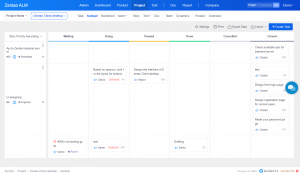Kanban: Stop Starting, Start Finishing
- 2020-08-03 14:53:00
- Renee Fey
- Original 7521
Kanban: Stop Starting, Start Finishing
Kanban is originated from Toyota Production Process(TPS) and means signboard. Kanban, in software development, is a framework used to implement agile projects. TPS is based on two concepts: jidoka("automation with a human touch") and just-in-time, which are reflected in Kanban method. Kanban, as an agile management method, requires real-time communication of capacity and full transparency of work. It emphasized a on-time delivery while team members are not overloaded. From the requirements to the delivery, a "pull" system is implemented.
Kanban in ZenTao ALM
Kanban Values
Team applying Kanban should embrace values that are emphasized in Kanban, including
- Transparency
- Balance
- Collaboration
- Customer Focus
- Flow
- Leadership
- Understanding
- Agreement
- Respect
Foundational Principle of Kanban
1. Change management principles
- start with what you do now
- agree to pursue improvement through evolutionary change
- encourage acts of leadership at every level - from the individual contributor to senior management
2. Service delivery principles
- understand and focus on your customers' needs and expectations
- manage the work; let people self-organize around it
- evolve policies to improve customer and business outcomes
General Practices of Kanban
Kanban does not have any predefined process for software development. The team can apply the elements of the Kanban to the existing workflow to expose the waste, uneven work, team overload, bottlenecks, defects and such in the system, as well as the risk of delay. Meanwhile, it gradually introduces the change of the process based on the problems found. Kanban is an empirical process. Below are six major practices (from the shallower to the deeper)
- Visualize the workflow
- Limit WiP(work in progress)
- Manage flow
- Make polices explicit
- Improve feedback loops
- Improve collaboratively, evolve experimentally
Cadences of Kanban
Cadences of Kanban are seven periodical meetings for aligning communication and driving evolutionary change.
- strategy review
- operations review
- risk review
- service delivery review
- replenishment meeting
- Kanban meeting
- delivery planning meeting
Cumulative Flow Diagram(CFD)
The number of products in process of each process stage of the Kanban system is recorded every day, and the cumulative daily situation is drawn to draw a cumulative flow chart. As shown in the figure: the vertical height represents how many products are in production at this stage of the process. If the vertical height is high, it may imply that the R&D process has a bottleneck or overloaded work in this area, which needs to be analyzed and resolved. The horizontal length represents the average cycle time of all work items from flowing into the R&D pipeline to the “done” line.
Reference
1. David J. Anderson and Andy Carmichael PhD. FBCS, Essential Kanban Condensed. First edition, digital version, 17 April, 2016.
2. Henrik Kniberg and Mattias Skarin. Kanban and Scrum - Making the Most of Both,

Products
- ZDOO
- ZDOO Cloud
Support
- Book a Demo
- Tech Forum
- GitHub
- SourceForge
About Us
- Company
- Privacy Policy
- Term of Use
- Blogs
- Partners
Contact Us
- Leave a Message
- Email Us: support@zentaoalm.com







